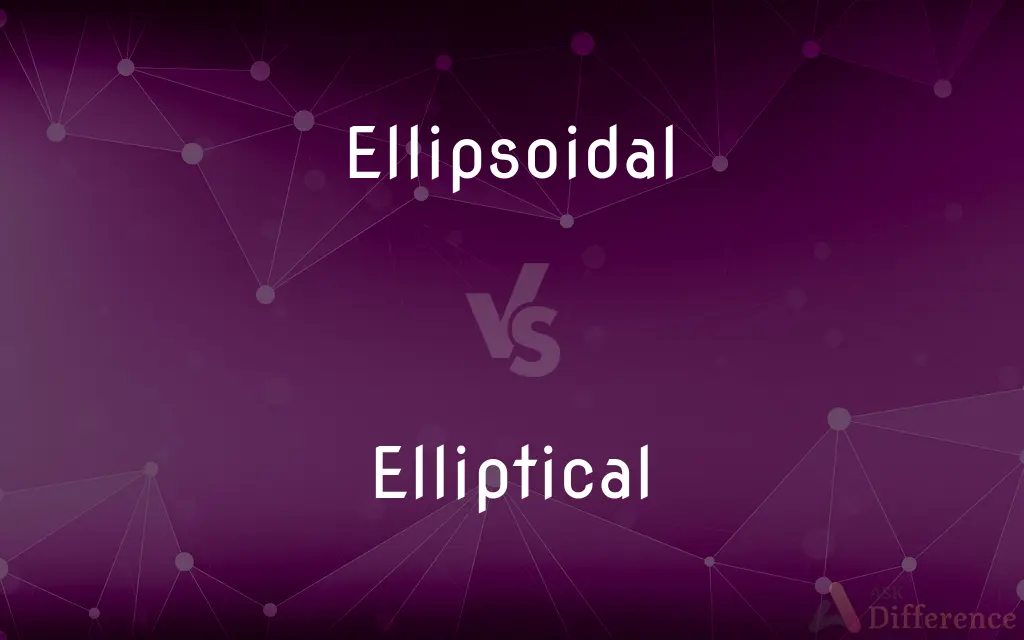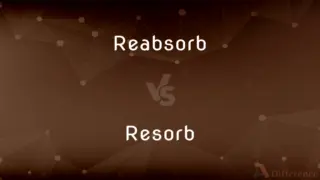Ellipsoidal vs. Elliptical — What's the Difference?
By Fiza Rafique & Urooj Arif — Updated on April 14, 2024
Ellipsoidal refers to a three-dimensional shape resembling an ellipse, focusing on volume, while elliptical generally describes a two-dimensional ellipse, emphasizing its flat, curvy nature.

Difference Between Ellipsoidal and Elliptical
Table of Contents
ADVERTISEMENT
Key Differences
Ellipsoidal shapes are three-dimensional with symmetrical curves around multiple axes, commonly seen in applications requiring a volume-centric approach such as in astronomy or physics. Whereas elliptical refers typically to two-dimensional forms, primarily used to describe flat, oval shapes like those of planets' orbits or the outline of an ellipse in mathematics.
Ellipsoidal structures often have practical implications in design and engineering, particularly when aerodynamics or light distribution is a concern, offering a continuous surface without edges. On the other hand, elliptical forms are frequently utilized in graphic design and architecture for their aesthetically pleasing curves and simplicity.
In geometry, an ellipsoidal figure is defined by equations that take into account its three axes (major, minor, and intermediate), which are crucial for understanding its shape in three-dimensional space. Elliptical, however, is described with just two axes (major and minor), simplifying calculations and visualizations in a flat plane.
Ellipsoidal coordinates are used in physics and mathematics to solve problems involving three-dimensional space where symmetrical properties about more than one axis are considered. Elliptical coordinates simplify these issues in two dimensions, often used in problems involving perimeter or area.
When manufacturing lenses and mirrors, ellipsoidal surfaces are crucial for focusing light correctly in devices like telescopes and projectors, exploiting their volumetric properties. Elliptical surfaces, however, are used in simpler optical devices, such as magnifying glasses, where the focus is more on the direct manipulation of flat surfaces.
ADVERTISEMENT
Comparison Chart
Dimensions
Three-dimensional
Two-dimensional
Usage in Mathematics
Describes volumes and surfaces
Describes areas and perimeters
Common Applications
Astronomy, physics
Graphic design, architecture
Defined by Axes
Three axes (major, minor, intermediate)
Two axes (major, minor)
Optical Applications
Lenses, telescopes
Magnifying glasses, simple optics
Compare with Definitions
Ellipsoidal
Pertaining to or shaped like an ellipse but with depth in three dimensions.
The planet's core is often modeled as an ellipsoidal figure due to its rotation.
Elliptical
Describing the rounded, closed curve that resembles a flattened circle.
Her glasses had a distinctly elliptical frame.
Ellipsoidal
Involving three-dimensional geometric calculations.
Computer graphics sometimes use ellipsoidal algorithms for rendering shapes.
Elliptical
Containing or characterized by ellipsing; omitting parts of words or sentences.
His writing style is notably elliptical, leaving much to the reader's interpretation.
Ellipsoidal
Related to an ellipse with an additional dimension.
Modern submarines have ellipsoidal sections to withstand deep-sea pressures.
Elliptical
A flat, oval shape used commonly in artistic designs.
The park's pathways are laid out in an elliptical pattern.
Ellipsoidal
A surface in which all cross sections are ellipses or circles.
Many radar domes are ellipsoidal to optimize signal direction.
Elliptical
Pertaining to orbits or motion resembling ellipses.
The planet follows an elliptical orbit around its star.
Ellipsoidal
Used in descriptions where symmetry around more than one axis is implied.
Ellipsoidal coordinates are preferred in nuclear physics experiments.
Elliptical
Of, relating to, or having the shape of an ellipse.
Ellipsoidal
A geometric surface, all of whose plane sections are either ellipses or circles.
Elliptical
Containing or characterized by ellipsis.
Ellipsoidal
Alternative form of ellipsoid
Elliptical
Of or relating to extreme economy of oral or written expression.
Ellipsoidal
(mathematics) Of or pertaining to an ellipsoid.
Elliptical
Marked by deliberate obscurity of style or expression.
Ellipsoidal
In the form of an ellipse
Elliptical
In a shape of, or reminding of, an ellipse; oval.
Elliptical
Of, or showing ellipsis; having a word or words omitted.
Elliptical
(of speech) Concise, condensed.
Elliptical
Elliptic.
Elliptical
(astronomy) An elliptical galaxy.
Elliptical
An elliptical trainer.
Elliptical
Containing or characterized by ellipsis;
The clause of comparison is often elliptical
Elliptical
Rounded like an egg
Elliptical
Characterized by extreme economy of expression or omission of superfluous elements;
The dialogue is elliptic and full of dark hints
The explanation was concise, even elliptical to the verge of obscurity
Common Curiosities
How are ellipsoidal and elliptical coordinates different?
Ellipsoidal coordinates address three-dimensional space considerations, whereas elliptical coordinates are tailored for two-dimensional spaces.
Can both ellipsoidal and elliptical shapes be used in optical designs?
Yes, ellipsoidal shapes are used in more complex optics like telescopes, while elliptical shapes are used in simpler applications like magnifying glasses.
What distinguishes an ellipsoidal shape from an elliptical shape?
Ellipsoidal shapes are three-dimensional, involving volume, while elliptical shapes are two-dimensional, focusing on area.
What are common examples of ellipsoidal objects in everyday life?
Common examples include watermelons and rugby balls, both of which have ellipsoidal shapes to optimize space and functionality.
In which scientific fields are ellipsoidal shapes particularly important?
Ellipsoidal shapes are important in fields like astrophysics, geophysics, and engineering, where understanding the distribution of mass and the behavior of forces in three dimensions is crucial.
What is an example of an elliptical orbit in astronomy?
An example is the orbit of Halley's Comet around the Sun, which is highly elliptical and brings the comet close to the Sun at perihelion and far at aphelion.
Can ellipsoidal shapes be created using only circular cross-sections?
Yes, ellipsoidal shapes can be generated by rotating an ellipse around one of its principal axes, producing circular cross-sections along one axis and elliptical cross-sections along the other two.
What role do elliptical patterns play in interior design?
In interior design, elliptical patterns are often used to create rhythms and focal points in spaces, influencing movement and attention through their curved lines.
How do the mathematical equations for ellipsoidal and elliptical shapes differ?
Mathematical equations for ellipsoidal shapes involve three axes and often include terms for each axis, while equations for elliptical shapes involve only two axes, focusing on length and width.
Why might a designer choose an elliptical shape over a circular one?
Designers might choose elliptical shapes for aesthetic diversity, efficient space usage, or dynamic visual impact in both architecture and product design.
How does the concept of ellipsoidal height differ from standard elevation measurements?
Ellipsoidal height is measured from the Earth's mean sea level modeled as an ellipsoid, differing from elevation measured from the actual sea level, which can vary due to geographical and gravitational factors.
Why are planetary bodies often approximated as ellipsoids in simulations?
Planetary bodies are often approximated as ellipsoids in simulations to simplify calculations of gravitational fields and satellite orbits, acknowledging their rotation and resultant bulging at the equator.
How do elliptical shapes benefit athletic tracks?
Elliptical shapes are used in athletic tracks to optimize space and enhance runners’ speed and safety in curves, offering a more ergonomic path that reduces the risk of injury and improves performance in track events.
Share Your Discovery

Previous Comparison
Reabsorb vs. Resorb
Next Comparison
Chicano vs. LatinoAuthor Spotlight
Written by
Fiza RafiqueFiza Rafique is a skilled content writer at AskDifference.com, where she meticulously refines and enhances written pieces. Drawing from her vast editorial expertise, Fiza ensures clarity, accuracy, and precision in every article. Passionate about language, she continually seeks to elevate the quality of content for readers worldwide.
Co-written by
Urooj ArifUrooj is a skilled content writer at Ask Difference, known for her exceptional ability to simplify complex topics into engaging and informative content. With a passion for research and a flair for clear, concise writing, she consistently delivers articles that resonate with our diverse audience.














































